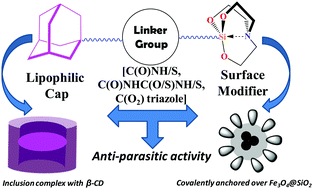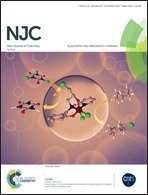Adamantylated organosilatranes: design, synthesis, and potential appraisal in surface modification and anti-protozoal activity†
Abstract
The present investigation evaluates the design and facile synthesis of a series of organosilatranes (1–7) tethered with the privileged adamantane motif, labelled as a ‘lipophilic bullet’, via numerous biocompatible linkages i.e. amide, ester, thioester, urea, thiourea, and thiocarbamate groups. The assembled silatranes have been scrupulously characterized by elemental analysis, FT-IR and NMR (1H and 13C) spectroscopy, and mass spectrometry. The parasitic diseases caused by unicellular protozoa, Giardia lamblia (G. lamblia) and Trichomonas vaginalis (T. vaginalis), represent a major health burden, therefore the synthesized compounds were probed for in vitro giardicidal and trichomonacidal activities. With this aim, firstly the pharmacokinetic profiles of the compounds were scrutinized using absorption, distribution, metabolism, excretion, and toxicity (ADMET) tools and on the whole, all compounds showed good oral bioavailability. The anti-parasitic activity of the newly synthesized compounds was evaluated in comparison to a standard drug (metronidazole) by 3-(4,5-dimethylthiazol-yl)-diphenyl tetrazolium bromide (MTT) assay. All the compounds displayed significant activity against G. lamblia and T. vaginalis with IC50 values ranging from 10.9–127.4 μM and 6.2–128.9 μM, respectively. To improve the aqueous solubility of the synthesized compounds, the enticing feature of the adamantane moiety to undergo inclusion binding with the β-cyclodextrin cavity is explored. Furthermore, a simplistic methodology is proposed to covalently anchor adamantylated silatrane onto the surface of magnetic silica nanoparticles. This material promises to be a non-invasive and externally controlled drug delivery system with enormous anti-protozoal potential.



 Please wait while we load your content...
Please wait while we load your content...